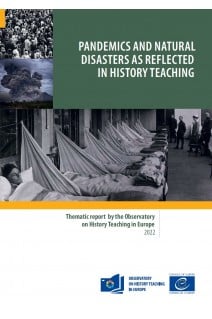Covid-19, disastrous series of earthquakes in Türkiye and Syria... How well prepared are young people to understand such catastrophic events and their impact upon societies?
Since the beginning of recorded human history, pandemics and natural disasters have highly impacted the historical narratives of mankind. Each time, they remind humans how fragile they are and how limited their knowledge is. Despite their impact, these events are given little attention in history education.
The first thematic report of the Observatory on History Teaching in Europe (OHTE) analyses how pandemics and natural disasters are taught across different levels of education. It gives a detailed overview of the teaching of the two topics in OHTE’s 16 member states, along with a cross country analysis – combining information provided by educational authorities and by history teachers themselves.
The report refers to important areas of concern such as the inclusion of pandemics and natural disasters in history curricula, teachers’ pedagogical decisions about their teaching, multiperspectival approaches but also the use of scapegoating during these times of crises.
The observatory’s mission is to provide a clear picture of the state of history teaching in Europe. Within the countries that are party to the observatory, this is done through OHTE reports on the state of history teaching and thematic reports, which explore particular areas of interest and how they are handled in history lessons. The observatory’s vision is embodied by its motto: “Teaching history, grounding democracy”. In practice, this means that it promotes quality history education in order to improve the understanding of democratic culture among young people. The Observatory on History Teaching in Europe is a Council of Europe enlarged partial agreement.
CHAPTER 1 – INTRODUCTION
Background and context
Pandemics: a historical perspective
Natural disasters: a historical perspective
The teaching of pandemics and natural disasters
The thematic report
CHAPTER 2 – RESEARCH METHODOLOGY
Cross-country comparative analysis
Challenges and limitations
CHAPTER 3 – INCLUSION IN SCHOOL CURRICULA AND TEACHER AUTONOMY
Albania
Andorra
Armenia
Cyprus
France
Georgia
Greece
Ireland
Luxembourg
Malta
North Macedonia
Portugal
Serbia
Slovenia
Spain
Türkiye
Cross-country comparison
CHAPTER 4 – TEACHING PRACTICES AND TEACHERS’ PERCEPTIONS
Teaching about pandemics and natural disasters: ages and stages
Teachers’ understanding of pandemics and natural disasters
Factors influencing the teaching of pandemics and natural disasters
The influence of experiences of pandemics and natural disasters on teaching
The influence of school history on the teaching of pandemics and natural disasters
The influence of information sources, community, friends and family
Teachers’ perceptions of history curricula relating to pandemics and natural disasters
The teaching of pandemics and natural disasters in the classroom
Conclusion
CHAPTER 5 – CONCLUSIONS, PRACTICES AND PERSPECTIVES
Main findings
Implications
REFERENCES APPENDIX 1 – RESPONSE RATES FOR THE TEACHERS’ AND EDUCATORS’ SURVEY
APPENDIX 2 – EXAMPLES OF INCLUSION OF PANDEMICS AND NATURAL DISASTERS IN HISTORY TEXTBOOKS IN GREECE
APPENDIX 3 – EXPERT GROUP MEMBERS AND OTHER CONTRIBUTORS




